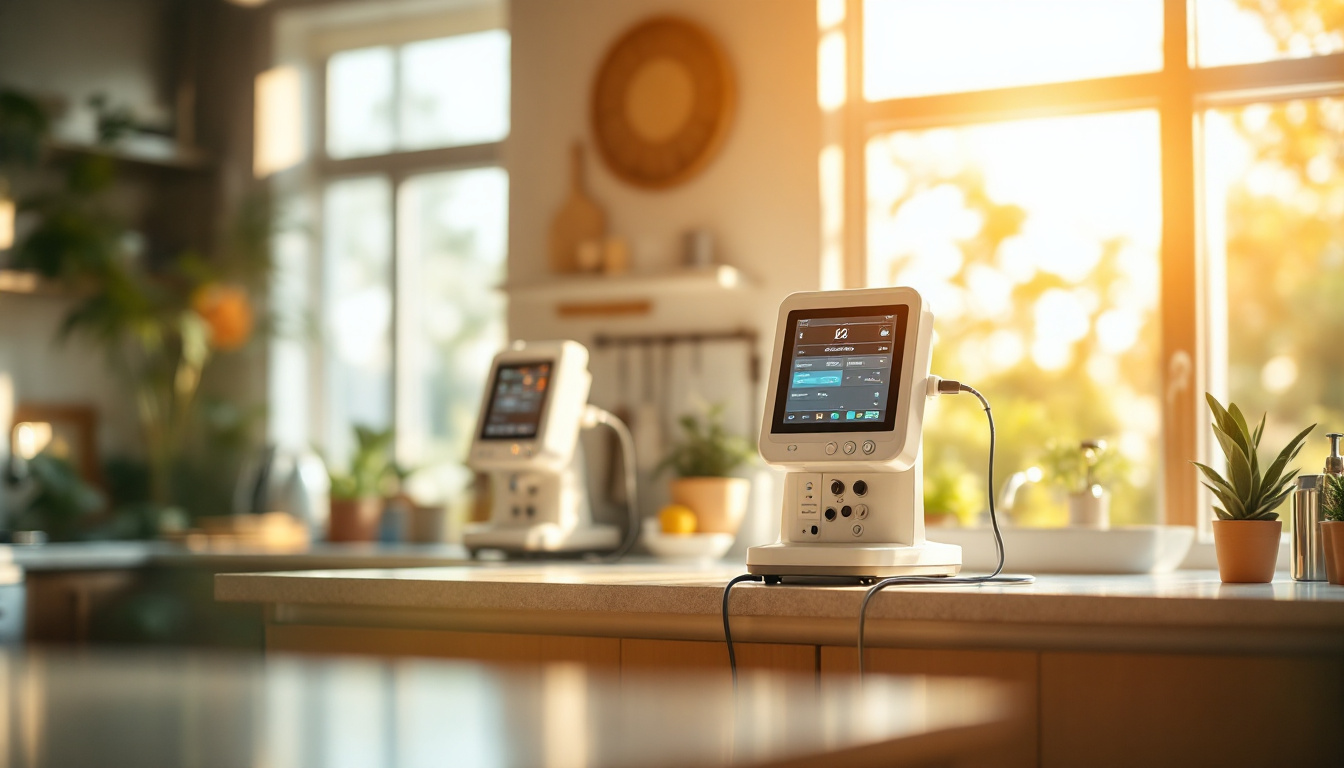How does sterile compounding improve infusion therapy?

Unpacking the Role of Sterile Compounding
Sterile compounding is a critical component in the preparation of medications for infusion therapy, providing patients with safe and effective treatments. This process ensures that infusion medications are free from contaminants, tailored to individual needs, and comply with rigorous safety standards. In this deep dive, we'll explore how sterile compounding enhances patient care, supports therapeutic outcomes, and adheres to best practices in healthcare.
The Fundamentals of Sterile IV Compounding

What is sterile IV compounding?
Sterile IV compounding is the meticulous process of preparing intravenous medications in a controlled environment, particularly a clean room that meets specific standards. This practice is crucial for ensuring that compounded sterile preparations (CSPs) are free from harmful microorganisms, which is especially important for patients with weakened immune systems, such as those receiving chemotherapy. By adhering to established procedures, sterile compounding significantly reduces contamination risks, thereby enhancing the efficacy of treatments and patient safety.
The preparation of these medications complies with strict regulatory guidelines, such as USP Chapter <797>, which provides directives to maintain sterility and patient safety during the compounding process. This ensures that medications administered through infusion retain their integrity and effectiveness, minimizing risks to patient health.
Role of pharmacy technicians
Pharmacy technicians are vital in the process of sterile IV compounding. They perform daily tasks essential to preparing and distributing sterile medications, such as:
- Measuring and mixing drug formulations following precise protocols.
- Maintaining cleanroom standards, ensuring that all surfaces and tools remain free of contaminants.
- Adhering to safety protocols during the compounding process to mitigate risks associated with microbial contamination.
The increasing complexity of medication regimens and the healthcare needs of the aging population drive up the demand for skilled pharmacy technicians. Certification in sterile compounding is becoming increasingly important, confirming their expertise and adherence to required practices. This focus on specialized training enhances the overall safety and quality of infusion therapies, ultimately benefiting patient care.
Why We Need Sterile Compounding in Infusion Therapy

Importance of Sterility
Sterile compounding is fundamental in infusion therapy as it prepares medications for direct administration into the bloodstream, where patients are at increased risk for infections. This process involves creating compounded sterile preparations (CSPs) in carefully controlled environments that adhere to rigorous standards, notably the USP <797> guidelines. These standards ensure the absence of harmful microorganisms, thereby safeguarding the integrity and potency of the medications.
By prioritizing sterility, healthcare providers can mitigate complications related to microbial contamination, which can lead to severe patient reactions including infections or adverse drug interactions. The use of aseptic techniques and environmental controls significantly bolsters patient safety during infusion therapy.
Impact on Patient Safety
Patient safety is paramount in healthcare, especially during infusion therapy. Compounding sterile preparations not only customizes medications for individual patient needs but also consolidates multiple prescriptions into simpler dosages. This approach can enhance adherence to treatment regimens—especially for sensitive populations like pediatrics and geriatrics.
Moreover, the integration of technology-assisted workflows in compounding practices leads to increased accuracy and reduced human error, thereby further protecting patients. Continuous training and adherence to safety protocols in sterile compounding practices ensure that health professionals maintain proficiency, leading to optimized patient safety and therapeutic outcomes in infusion therapy.
Patient Safety and Treatment Effectiveness

How does sterile compounding enhance patient safety and treatment effectiveness?
Sterile compounding plays a crucial role in enhancing patient safety and treatment effectiveness by preparing medications, particularly injectable ones, within contamination-free, controlled environments. By adhering to rigorous guidelines such as USP <797>, facilities minimize the risks associated with microbial contamination. This is vital, especially for vulnerable populations who are more susceptible to infections, as sterile environments drastically reduce the likelihood of adverse drug reactions arising from contaminated drugs.
Moreover, sterile compounding allows for the customization of medications, catering to individual patient needs like allergies or unique dosage requirements. This tailored approach not only improves therapeutic outcomes but also increases patient adherence to their treatment plans. For instance, patients requiring medication combinations can benefit significantly from compounded sterile products that simplify their regimens.
Benefits of Technology in Sterile Compounding
Technological advancements are revolutionizing sterile compounding practices, further improving patient safety and treatment effectiveness. Technologies, such as technology-assisted workflow systems (TAWS) and barcode scanning, enhance accuracy in medication preparation. Studies have shown that these automated systems have significantly lowered rates of medication errors—detecting issues during drug withdrawal and injection processes more effectively than manual techniques.
In addition, using automation increases the number of safety checks performed during the compounding process, which improves traceability and accountability for medication preparation. This sophisticated approach not only minimizes human error but also promotes adherence to safety protocols, ensuring that compounded sterile preparations maintain their intended purity and potency.
Overall, the integration of stringent compounding practices and technology-driven solutions creates a solid framework for improving patient care, ultimately leading to better health outcomes in infusion therapy.
Contrasting Sterile and Non-Sterile Compounding

What is the difference between sterile and non-sterile compounding?
The distinction between sterile and non-sterile compounding is primarily defined by the intended use of the medications and the associated infection risk.
Sterile Compounding
Sterile compounding is specifically designed for medications that are administered through routes with a high risk of infection, such as intravenous (IV) injections.
- A controlled environment adhering to strict standards, like USP <797>, is mandatory to prevent contamination.
- Pharmacists must utilize personal protective equipment (PPE) and apply aseptic techniques to ensure sterility.
- Examples include injectable medications, IV solutions, and certain ophthalmic products.
Non-Sterile Compounding
In contrast, non-sterile compounding pertains to medications with a lower risk of infection.
- This includes formulations such as oral medications, topical treatments, and creams, which do not necessitate a sterile room.
- Though cleanliness is still essential, the requirements are less stringent than in sterile compounding.
- For example, compounding for a topical antibiotic or an oral suspension involves practices that focus more on cleanliness rather than the absence of all microorganisms.
| Aspect | Sterile Compounding | Non-Sterile Compounding |
|---|---|---|
| Risk | High (infection risk) | Low (lower infection risk) |
| Environment | Controlled sterile environment required | Less stringent cleanliness requirements |
| Examples | Injectable medications, IV solutions | Oral medications, topical creams |
| Procedural Controls | Stricter, includes PPE and aseptic techniques | Standard cleanliness, fewer controls |
Overall, understanding these differences is vital for ensuring appropriate medication preparation methods that maximize patient safety and therapeutic effectiveness.
Risks of Improper Compounding in Infusion Therapy
What are the risks and complications associated with improper compounding in infusion treatments?
Improper compounding in infusion treatments significantly elevates risks and complications. One notable issue is the absence of stringent regulatory oversight for compounded medications compared to FDA-approved alternatives. Compounded sterile preparations (CSPs) may not meet the established quality standards, putting patients at risk of contamination. Microbial contamination can lead to serious infections, which are particularly dangerous for patients receiving intravenous therapies since their immune defenses may be bypassed.
Errors in compounding, such as using incorrect ingredients or incorrect quantities, can further jeopardize patient safety. These mistakes might render medications ineffective or even toxic, thus underscoring the critical need for precision in compounding.
What are historical examples that illustrate these risks?
Historical events highlight the severe implications of improper compounding practices. For instance, the 2012 fungal meningitis outbreak was linked to contaminated CSPs from a compounding pharmacy. This crisis affected over 800 patients, with numerous fatalities, starkly illustrating the consequences of defective sterile compounding. Such incidents underscore the importance of adhering to regulatory standards like USP <797>, which are designed to minimize contamination risks and safeguard patient health.
Furthermore, compounded drugs are not subject to mandatory adverse event reporting to the FDA, complicating the tracking of safety issues. This lack of transparency can contribute to ongoing dangers related to compounded medications, as patient health may be continuously jeopardized without adequate oversight.
By recognizing these risks and complications, healthcare providers can better appreciate the necessity of stringent compounding practices, ultimately enhancing patient safety during infusion therapy.
Standards and Regulations in Sterile Compounding
Best Practices for Sterile Compounding in Healthcare
Sterile compounding is vital for patient safety and the effective administration of infusion therapies. The standards set forth by the United States Pharmacopeia (USP) Chapter <797> are the cornerstone for best practices in healthcare. These guidelines specify rigorous protocols and aseptic techniques to ensure that compounded sterile preparations (CSPs) maintain sterility, quality, and stability.
Key best practices include:
- Aseptic Techniques: Proper methods for compounding to prevent microbial contamination.
- Cleanroom Conditions: Adhering to ISO Class 5 environments where CSPs are prepared.
- Use of PPE: Personal protective equipment is essential to safeguard both patients and healthcare personnel.
- Environmental Monitoring: Regular checks on air quality and cleanliness to uphold sterility protocols.
- Training and Competence: Continuous education for compounding staff about evolving protocols and diminishing risks of error.
Role of Regulatory Bodies
Regulatory frameworks are also critical in the field of sterile compounding. The FDA and state pharmacy boards oversee compliance with safety standards and regulations, ensuring that all facilities follow the guidelines set by USP.
Their oversight ensures:
- Quality Assurance Programs: Mandate that compounding pharmacies implement monitoring systems that emphasize safety.
- Certification Processes: Establish that personnel are well-trained and competent.
- Regular Inspections: Help enforce compliance and identify insanitary conditions in compounding pharmacies.
The synergy between best practices, regulatory compliance, and continued education creates a robust framework for sterile compounding, significantly enhancing patient safety during infusion therapy. Eighty-eight percent of healthcare professionals recognize that adhering to regulations improves outcomes and reduces the risk of contamination and errors.
Continuous Evaluation of Compounding Techniques
Importance of Regular Reviews
Continuous evaluation of sterile compounding techniques is vital for ensuring the safety and efficacy of infusion therapies. Regular reviews help identify potential areas for improvement and mitigate risks associated with contamination or incorrect dosages.
Evaluation Frequency:
- Sterile compounding techniques for IV pharmacy technicians should be reassessed every six months. This interval allows for the adaptation to any changes in regulations or practices while ensuring compliance with established safety and quality standards.
- Personnel involved in overseeing compounding operations should also undergo annual garbing competency evaluations to maintain adherence to sterile techniques.
- Keeping detailed records of evaluations and training is essential; they should be retained for at least two years to ensure accountability and compliance with state regulations, such as those prescribed in the Texas Pharmacy Act.
Training for Pharmacy Technicians
Ongoing education and training are critical components of maintaining high standards in sterile compounding. Pharmacy technicians must be well-versed in the latest protocols and best practices to minimize risks during medication preparation.
- Training programs should include updates on USP <797> standards and current aseptic techniques. This helps technicians navigate changes in regulations effectively, promoting safe practices.
- Utilizing technology-assisted workflow systems (TAWS) can enhance training by providing real-time feedback and improving error detection in compounding processes.
- Continuous professional development reinforces the importance of quality assurance in compounding pharmacies, ultimately improving patient safety and therapeutic outcomes.
The Role of Aseptic Techniques in Sterile Compounding
What is the significance of using aseptic techniques in sterile compounding?
The significance of using aseptic techniques in sterile compounding lies in their critical role in preventing contamination and infection, particularly in intravenous (IV) medications. Aseptic techniques are designed to minimize exposure to microorganisms by following rigorous protocols such as:
- Maintaining sterile environments within clean rooms.
- Using barriers like masks, sterile gowns, and gloves.
- Adhering to strict contact guidelines to prevent microbial transfer.
These practices are essential for ensuring that compounded sterile preparations (CSPs) are safe, effective, and free from harmful microorganisms. Compliance with quality standards, particularly USP <797>, contributes significantly to the safety and efficacy of these preparations.
How does compliance with USP <797> enhance patient safety?
Adherence to USP <797> is vital for minimizing the risk of contamination during the preparation of CSPs. Key compliance measures include:
| Protocols | Description |
|---|---|
| Clean Room Standards | Utilize certified clean rooms to ensure air quality. |
| Personal Protective Equipment | Use of PPE is mandated to reduce contamination risk. |
| Aseptic Techniques | Strict adherence to aseptic methods during preparation. |
Furthermore, the effective implementation of these guidelines helps to avoid healthcare-associated infections, a major concern for patients receiving IV therapies. Infections associated with IV catheters can lead to significant health complications. Therefore, healthcare professionals—including pharmacists and pharmacy technicians—must be properly trained and certified in aseptic techniques.
Ultimately, maintaining high standards in sterile compounding is vital for protecting patients, especially those with compromised immune systems, and ensuring high-quality care in infusion therapy.
Technological Advancements in Sterile Compounding

What advancements in sterile compounding technologies impact infusion safety?
Recent advancements in sterile compounding technology have significantly enhanced infusion safety by mitigating errors and improving the sterility of prepared medications.
Robotic Automation and Automated Compounding Devices
These technologies have revolutionized the preparation process. They excel at accurate measurement and dispensing, which minimizes the risk of human error.Closed System Transfer Devices (CSTDs)
CSTDs are crucial for reducing contamination risks during the transfer of hazardous substances. Utilizing these devices protects both healthcare personnel and patients from exposure.Real-time Monitoring Technologies
These systems ensure that critical parameters—such as particulate and microbial counts—are within safe ranges during compounding. They play a vital role in maintaining compliance with rigorous safety standards.Technology-Assisted Workflow Systems (TAWS)
The implementation of TAWS has demonstrated substantial benefits. Studies indicate that TAWS has reduced medication errors from 0.4% with manual processes to 0%, enhancing verification processes and overall safety.Integrated Compliance Solutions
These tools facilitate adherence to regulatory guidelines like USP <797>. By streamlining workflows and providing real-time data on compounding practices, integrated solutions foster high compliance levels, which are vital for maintaining patient safety.Ongoing Education and Training
As technologies evolve, continuous professional development is essential. It equips pharmacy personnel with the knowledge needed to effectively incorporate new tools while upholding stringent safety standards in sterile compounding practices.
In summary, the integration of these advanced technologies not only enhances the quality and sterility of compounded sterile preparations (CSPs) but also significantly reduces the risk of contamination and errors during infusion therapy.
Influence of Compounding Practices on Patient Care
How do sterile compounding practices influence patient care in infusion therapy?
Sterile compounding practices play a crucial role in patient care during infusion therapy. By ensuring that injectable medications are free from contamination, these practices significantly reduce the risk of infections and adverse drug reactions. The use of aseptic techniques, outlined in regulatory guidelines such as USP Chapter <797>, is fundamental in preparing compounded sterile preparations (CSPs) safely.
Customization through sterile compounding allows healthcare providers to address specific patient needs, particularly for those requiring tailored dosages or allergy-friendly formulations. For instance, pediatric and geriatric patients can benefit from medications specifically designed for their unique physiological requirements. This level of individualized care not only enhances treatment efficacy but also boosts patient satisfaction.
Moreover, adherence to industry regulations ensures that all compounded medications maintain high safety standards, which directly influences positive patient outcomes. Facilities practicing stringent quality assurance—through environmental monitoring and personnel training—produce higher-quality CSPs, subsequently lowering the risk of complications in patients receiving infusion therapies.
Efficiency in compounding practices, including the implementation of technology-assisted workflow systems (TAWS), greatly enhances safety. Such systems increase the accuracy of medication preparation and reduce human error, ensuring correct dosing and adherence to protocol. Lean batching methods also streamline production, resulting in reduced waste and improved resource utilization within healthcare settings.
Overall, the integration of continuous staff education on sterile compounding techniques, combined with rigorous quality control measures, is vital for delivering safe and effective infusion therapies that significantly improve patient care.
Understanding USP Chapter <797> and Its Impact
Overview of USP Chapter <797>
USP Chapter <797> lays out the standards for preparing compounded sterile preparations (CSPs) to ensure medication safety and efficacy, particularly for infusion therapies. This chapter specifies the environmental conditions necessary for compounding, including air quality standards, and it emphasizes the need for aseptic techniques to prevent contamination.
The implementation of these standards is crucial for pharmacies and healthcare providers engaged in sterile compounding, guaranteeing that all compounded medications maintain their integrity before administration.
Importance in Sterile Compounding
The guidelines established in USP Chapter <797> are vital for protecting patient safety. By adhering to these standards, practitioners can mitigate risks of microbial contamination, which can significantly harm patients receiving infusion therapies.
Furthermore, compliance with these regulations ensures that compounded medications are prepared with the correct strength and sterility. Ongoing education and training within healthcare settings are essential to ensure staff are knowledgeable about these evolving standards, which aim to optimize therapeutic outcomes in patients who rely on custom medications.
Customizing Medication for Diverse Patient Needs
Benefits for Specific Patient Populations
Sterile compounding plays a vital role in tailoring medication therapies for patients with unique needs, such as allergies or specific dosage requirements. This is particularly crucial for sensitive populations like pediatric and geriatric patients. For example, pharmacists can create custom formulations that cater to a child's weight or a senior’s ability to swallow pills, thereby enhancing treatment tolerability.
Additionally, sterile compounding allows for the production of allergy-friendly formulations, which can prevent adverse reactions in patients sensitive to certain ingredients. This customization is not typically available in standard medications, providing a significant benefit to patients requiring specialized treatment options.
Enhanced Compliance and Adherence
By providing customized solutions, sterile compounding enhances medication compliance. For instance, pharmacists can combine multiple prescriptions into a single dosage form, simplifying the patient’s regimen. This approach makes it easier for patients to adhere to their therapy, as fewer medications can decrease the chances of forgetting doses.
Furthermore, creating formulations that are more palatable or easier to administer can significantly motivate patients towards consistent treatment. Such improvements in the patient experience ultimately lead to better therapeutic outcomes, reinforcing the importance of sterile compounding in personalized medicine.
Best Practices for Aseptic Techniques in Infusion Therapy
Ensuring safety and efficacy
The practice of sterile compounding is integral to infusion therapy, safeguarding patient health by preventing contamination during drug preparation. Adhering to strict protocols outlined in USP Chapter <797> helps ensure that compounded sterile preparations (CSPs) are both safe and effective. By utilizing aseptic techniques, healthcare professionals can significantly reduce the risk of delivering contaminated medications, which is particularly critical for patients receiving intravenous (IV) therapies.
Maintaining controlled environments, such as certified clean rooms, is essential. These areas are designed to uphold stringent air quality standards, ultimately protecting CSPs from harmful microorganisms. The implementation of technology-assisted workflow systems (TAWS) further enhances this safety framework by streamlining processes and decreasing the likelihood of human error.
Key procedural elements
When compounding sterile preparations, several procedural elements are vital:
- Training and Competency: All personnel involved in aseptic techniques must undergo ongoing education and training to ensure competence and compliance with safety standards.
- Environmental Controls: Regular monitoring of air quality, personnel hygiene, and facility cleanliness is crucial to eliminate contamination risks.
- Personal Protective Equipment (PPE): The use of PPE and closed-system drug-transfer devices (CSTDs) is vital in minimizing exposure to potentially hazardous substances.
By following these best practices, healthcare providers can deliver high-quality infusion therapies, thereby improving patient safety and treatment outcomes.
Global Standards and Regulations in Sterile Compounding
International Guidelines
Sterile compounding practices are heavily influenced by international standards, most notably the United States Pharmacopeia (USP) Chapter <797>. This regulation establishes enforceable guidelines for pharmacies involved in compounding sterile preparations (CSPs), ensuring that the medications meet stringent safety and quality criteria. Other regions, such as Europe, follow similar directives, such as the European Medicines Agency (EMA) guidelines, which also prioritize patient safety and drug efficacy in sterile compounding.
Cross-border Differences
Variations exist in regulatory practices across countries. While USP <797> forms the backbone of sterile compounding standards in the U.S., other nations may enforce different frameworks, affecting how medications are compounded. For example, Canada follows its own pharmaceutical compounding standards, adding another layer of complexity in cross-border healthcare. These differences necessitate ongoing education and training for pharmacists and healthcare providers to ensure compliance and safeguard patient health across jurisdictions.
| Region | Key Standards | Impact on Compounding |
|---|---|---|
| United States | USP <797> | Enforces strict sterility guidelines |
| Canada | Canadian Compounding Standards | Requires adherence to specific protocols |
| Europe | EMA Guidelines | Aligns with EU directives for safety |
This matrix highlights just some of the regulations that pharmacies must navigate in practice. As standards continue to evolve, understanding these regulations is critical for competent and safe medication preparation.
Final Thoughts on Sterile Compounding’s Contribution to Infusion Therapy
Sterile compounding stands as a cornerstone in the realm of infusion therapy, ensuring that treatments are not only safe but also customized to the unique needs of each patient. Its importance cannot be overstated in the prevention of contamination and enhancement of patient outcomes. Adhering to strict standards, such as those outlined in USP Chapter <797>, and embracing technological advancements, are essential for maintaining high-quality compounding practices. As regulations continue to evolve, consistent training and education will remain pivotal in enabling healthcare professionals to deliver effective and safe infusion therapies. The informed application of these practices fosters a more efficient healthcare system and promotes better therapeutic success across patient populations.
References
- Importance of sterile compounds in infusion - Pharmko
- How does sterile compounding optimize patient therapy? - Pharmko
- [PDF] ASHP Guidelines on Compounding Sterile Preparations
- [PDF] Crucial Considerations to Ensure the Safety of IV Therapy
- Sterile Compounding Resource Center |Best Practices and methods
- Compounded Sterile Preparations Pharmacy Specialty Certification
- Impact of technology-assisted versus manual sterile compounding ...



































































































